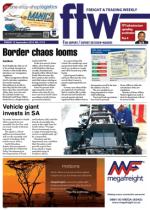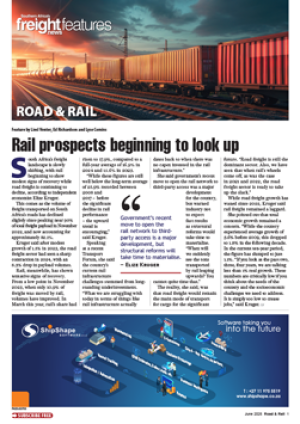If the Maersk/MSC 2M vessel
sharing agreement (VSA)
gets official approval from
the US Federal Maritime
Commission (FMC) next
month, it should mark the
start of a monumental modal
shift for US import cargo from
Asia, according to Marco
Pluijm, ports sector manager
of Bechtel, speaking at last
week’s African Ports Evolution
Conference in Durban.
And, according to the US
press, the beginning of the 2M
joint operations in the eastwest
trades may be as soon as
early next year if the two lines
get the nod from the FMC.
They should know by October
11 whether they will be allowed
to go ahead in the US trades.
And this time it is unlikely
that the Chinese authorities
will veto the two-line deal.
First, because it is considered
to be no more than a pure
VSA, with none of the other
marketing and operational
agreements of the previous
Maersk/MSC/CMA CGM P3
network which China snubbed
earlier this year.
And secondly, the US –
where ocean carriers are
subject to the requirements
of the Shipping Act of 1984
administered by the FMC
– is the only jurisdiction in
which 2M needs to receive
explicit approval, according
to Maersk and MSC.
When (or still possibly
if) this VSA is approved, an
intriguing situation arises.
On the current Asia to
North Europe trade, the two
lines – plus others, like CMA
CGM and UASC – are using
the new mega container ships
of 18 000 TEU plus capacity.
These can sail through the
Suez Canal.
And the logic is that larger
capacity vessels could also be
deployed on the Asia-US East
Coast (USEC) run, where
the current largest are about
10 000 TEU, according to
Pluijm.
Figures he quoted from
an IAPH/Drewry survey in
April this year showed that
the largest vessels on the three
main routes from Asia were
all larger than that. As we
said, 18 000+ TEU on Asia-
Northern Europe; 14 000 on
Asia-Mediterranean and Asia-
Middle East; and 13 800 on
Asia-US West Coast (USWC).
But there’s a lot of extra
cargo available once larger
vessels start calling on USEC
as the 2M intends. And that,
according to Pluijm, could
come from cargo ultimately
bound for the East Coast and
its western hinterland which
currently arrives at West
Coast ports.
He then explained the logic
behind the anticipated modal
shift.
“Currently up to 70% of
the West Coast containers
move East by rail and road,”
said Pluijm. “If we assume
that 15-20% of West Coast
containers move all the way to
the East Coast, this equals 3
to 4 million TEUs a year.”
And there are considerable
savings to be made, along
with a much better “green”
profile, if that cargo goes
direct by sea to the East
Coast, rather than road/rail
from the West.
When these containers shift
from overland transport to
all-water, direct import via the
Suez Canal on bigger carriers,
what would be the savings?
Said Pluijm: “It would be
20-30% on direct freight costs
from the Far East to the USEC
due to the all-water economy
of larger-scale shipping.
“Also 30-40% (or even
more) on direct freight costs
due to a 40-50% shorter
overland transport distance in
the US itself.
“And 20-30% in emission
on the all-water route
(lower fuel consumption,
more efficient engines) plus
40-50% reduction in overland
emission.”
A massive modal shift
purely from cargo bound
for the East Coast and its
immediate hinterland, but
one with distinct savings,
according to Pluijm.
INSERT & CAPTION
West Coast containers
that currently move
East by rail and road
could now move all
the way to the East
Coast by sea, resulting
in huge cost savings.
– Marco Pluijm

